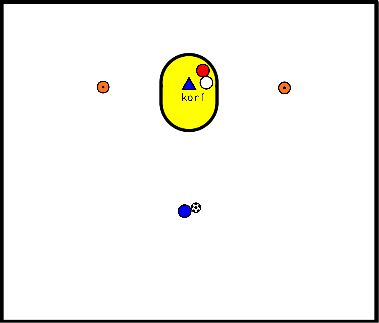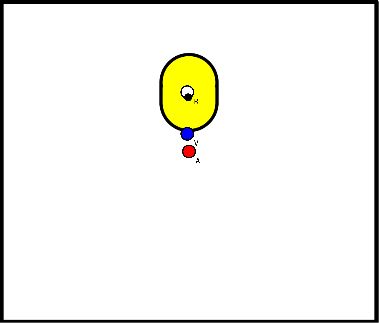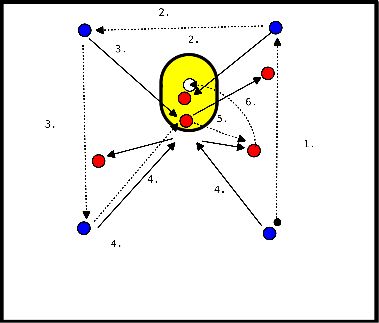Korfball exercises for u11
Shooting game where they get to take a card when they have scored.
- Each playing card shows a "color": clubs, spades, hearts or diamonds.
- Each color represents a fitness exercise:
- Hearts: Push-ups
- Spades: Squat
- Clubs: Burpee
- Diamonds: Lunges
- Once they have picked a card, they must first perform the corresponding exercise.
- They do this the number of times the card indicates.
- For example, Hearts 4 = push up 4 times.
- Then they may continue shooting again.
- The group with the most cards has won.
- On both sides of the basket are pawns.
- The shooter stands in front of the basket with the ball.
- The other players stand under the basket to duel for the rebound.
- After each shot, one player catches the ball.
- This player must first tap a pawn and then may catch again.
- The shooter shoots as soon as he has the ball.

Put at least half the baskets of the number of players participating.
- One player with ball stands under each basket
- The remaining players stand in the middle between the set up baskets
- Have the players walk to a basket and pull a hook and then shoot it
- If the shot is on a normal basket the player gets 1 point
- Is the shot in at a shooter's basket then you get 2 points
- If the player has scored, he walks to the center and chooses another basket to shoot at.
- If the player did not score then you switch with the passer.
- Play to your own choice of points
To make the run-throughs a little more fun, we'll make it a contest!
- You put a number of baskets in a circle with one passer on each occasion.
- There are also more players than baskets in the middle
- Every run through counts for 1 point
- If you score a run-through, you take your turn
- If you miss the follow-through, you and the server swap positions
- The first player to score 6 points wins. Number of points to be determined on what the players can do.
variation:
- you can do different sizes of baskets and give them a different score
- for example an archer basket counts for 2 points
Objective:
- A combination of moving, passing and shooting
- An easy exercise to teach a pull away ball
Description:
- The player at the post pulls away, gets the ball and shoots.
Directions you can give:- all in quick succession
- good tight pass
- do not pull away right behind the post, difficult for a good pass
- The passer goes to catch the ball and there is a change of position
Variation:
- The catcher may shoot 1 more time himself if he/she catches the ball without colliding
You stand in pairs on a pole
- 1 in front of basket at shot distance
- 1 player is rebounder/forward
The rebounder gives a pass to the attacker standing at shot distance.
- if the rebounder can catch the ball without it colliding he may shoot
- if the ball bounces first, the shooter can continue playing
- this way all players play against each other to score 5 points for the fastest score.
- Attacker and defender ready for the post. Offender under the post with ball.
- Defender moves up post.
- Play 1 x 1 until attacker has scored 1 time. Defender always tries to be there.
- The post of the defender who got the goal against gets penalty.
- Defender goes back to own post.
- Passing

Building up to offensive positions to fall back on when creativity fails for a while.
Blue = static starting positions
Setup:
- Pass deep from front field
- Pass laterally into backfield + rebound run in
- Pass deep from backfield + run in support
- Pass passed to incoming support + attacking action by both strikers
- Support plays free striker + runs out into space
- Offloaded striker shoots
Once static has been mastered, move to dynamic. Agreement is that support follows immediately after rebound. The rest can be filled in freely with the variations below:
- Support runs around the block instead of cutting into it.
- Support does not shoot, but plays shadow striker to shoot. 7a.
- Offloaded striker does not shoot, but plays run-out striker to shoot. 7b.
- Played run-out support does not shoot, but shadow striker runs into support and takes over function + attack action strikers and shoot. 8.
- Played run-out support does not shoot, striker runs into support and takes over function + shadow striker connects with run-out support + strikers attack action and shoot. 9.
- ... innumerable variations to think of

Building up to offensive positions to fall back on when creativity fails for a while.
Blue = static starting positions
Setup:
- Pass deep from front field
- Pass laterally into backfield + rebound run in
- Pass deep from backfield + run in support
- Pass passed to incoming support + attacking action by both strikers
- Support plays free striker + runs out into space
- Offloaded striker shoots
Once static has been mastered, move to dynamic. Agreement is that support follows immediately after rebound. The rest can be filled in freely with the variations below:
- Support runs around the block instead of cutting into it.
- Support does not shoot, but plays shadow striker to shoot. 7a.
- Offloaded striker does not shoot, but plays run-out striker to shoot. 7b.
- Played run-out support does not shoot, but shadow striker runs into support and takes over function + attack action strikers and shoot. 8.
- Played run-out support does not shoot, striker runs into support and takes over function + shadow striker connects with run-out support + strikers attack action and shoot. 9.
- ... innumerable variations to think of

- Build up to offensive positions to fall back on when creativity fails.

Everyone takes 2 penalty throws.
- If you miss, you have to run across the width of the field with the whole team.
- If you miss 2 times, you must run back and forth with the whole team.

Setup:
- X number of baskets.
- Use colored dice corresponding to color baskets.
Variation 1:
- Have the players use the dice to determine how many shots/ chances to score/take at each basket.
- They may take the ball to the other basket while running. Dribble down the court.
Variant 2:
- Different types of chances!
- 1 hand, penalty throw, through ball while running with the ball, etc.
Variant 3:
- Have the players use the dice to determine how many shots/opportunities to score/take at the basket corresponding to the color of the die.








